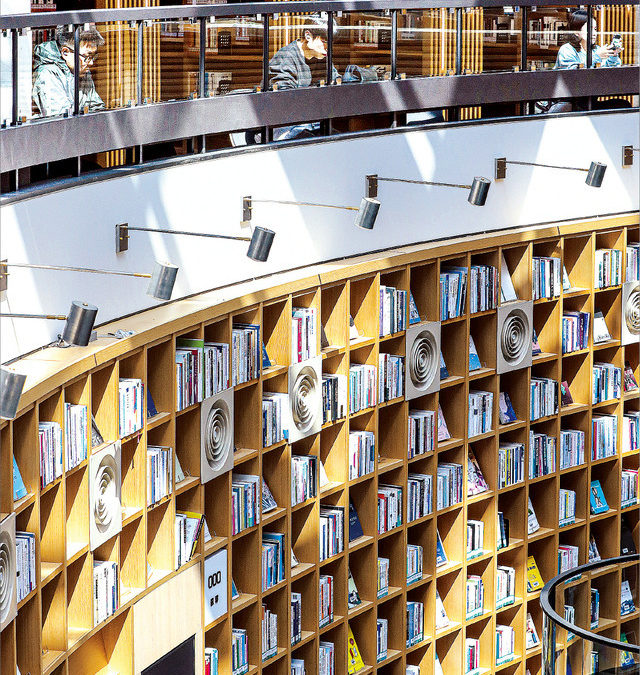In culturally vulnerable rural areas, libraries are more than just a place to read books. It’s a place for residents to build their minds, create a sense of community, and relax. It is also a special space for visitors to understand the local area. In June last year, the Inje Miracle Library opened in Inje, Gangwon-do, and within six months of its opening, 50,000 people visited it, more than the 30,000 people in the area. The library is creating a miracle of overcoming rural depopulation. We headed to Inje to see this miracle in action.

Sunlight fills the library thanks to the windows in the ceiling. Inje=Seungchul Baek, freelance photographer
Square building, square bookshelves, square desks and books lined up front and back. This is what comes to mind when you think of a library. the Inje Miracle Library breaks this stereotype right from the start.
The main library building is cylindrical in shape. Upon entering, the books lining the rounded walls are jaw-dropping. The books are out of reach of humans, which is both a soundproofing feature and a preservation in itself. Windows in the ceiling fill the library with sunlight. The shadows of the window frames and solar panels create a constantly changing pattern on the library floor. In the center of the round hall, a cascading desk is placed so that patrons can read or study in natural light. “I’m preparing for a job in my hometown, and it’s great to have such a nice library, which is hard to find even in the city,” said Kim Soo-min, 25, a resident of Inje-eup. “Moreover, the free access to the open space helps me overcome the stress of preparing for a job.”

An extended reality (XR) museum lets you use a joystick to feel like you’re walking through a real museum. Inje=Seungchul Baek, freelance photojournalist
Throughout the library, there are many state-of-the-art spaces with fun features not found in traditional libraries. On the first floor, a television screen in the XR (Extended Reality) Museum displays a realistic art museum. You can move the joystick to walk around the museum and select the artwork you want to see, and the headset will give you a detailed description of the artwork.
Heading down from the first floor hall is an open theater with a staircase. The stage at the end of the stairs hosts book talks and lectures by famous people. It changes the perception that libraries are supposed to be quiet spaces. On the second floor, there are six rooms where you can enjoy your hobbies. Each room has a theme, such as the music studio, where you can play the electronic piano, and the art studio, where there is a large table with drawing paper. Local residents gather and interact through club activities, creating a sense of community as “villagers”.

In the media art room, the birch forest of Inje fills the room through a beam projector. Inje = Seungchul Baek, freelance photographer
In particular, the Inje Miracle Library attracts attention because it makes the most of the local identity. The monitors in the space called “Ingenia” show videos about Inje’s ecology and culture and literary works set in Inje. Both locals and visitors from far away can understand what kind of place Inje is. In the media art room, a beam projector shows images of Inje’s birch forest and Seoraksan Mountain on the entire wall, making you feel like you’re in the middle of nature.
“We created this space for Inje children who, unlike children living in the city, have fewer opportunities to experience media art,” said Shim Min-seok, director of the museum. “It is even more meaningful because it shows the natural scenery of Inje.”
The Inje Miracle Library was built as part of a library construction project by the Book Reading Society Cultural Foundation. The organization commissioned Yonsei University Professor of Architecture and Engineering Lee Sang-yoon and an architectural firm to design the library and donated the completed design.
In July 2019, Inje-gun began construction of the library with a building area of 3,000 square meters (906 square feet) on a site of 10,000 square meters (3,000 square feet) by investing 18 billion won ($18 billion) in military expenditures plus national and provincial funds. The library was completed in December 2022, after three and a half years of construction. In February of this year, the Korean Institute of Culture, Space, and Architecture selected the Inje Miracle Library for the Korean Cultural Space Award in the library category.

‘Ingenia’ shows the ecology and culture of Inje through videos to help you understand the region. Inje = Seungchul Baek, freelance photojournalist
Before the library was built, local families with young children often had to drive to the neighborhood because they had nowhere else to spend their time. Now, both children and parents spend their weekends at the library reading books. In addition, the library holds various performances such as small concerts and children’s puppet shows, providing something to see for residents who are often marginalized from cultural life. The Inje Miracle Library also attracts people who live far away. They visit other tourist spots and restaurants in Inje, boosting the local economy.
“We tend to focus on job creation to solve rural depopulation, but expanding places to enjoy cultural life is equally important,” said Ahn Chansu, executive director of the Book Reading Society Culture and Culture Foundation. “Building libraries is a great way to transform a region into a better place to raise children and live.”
Inje=Jiwon Hwang Reporter support@nongmin.com
Source : nongmin.com
